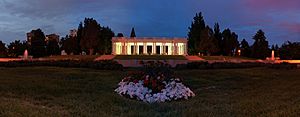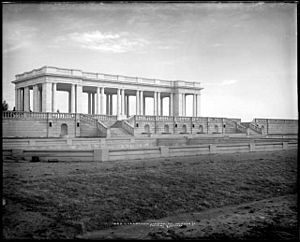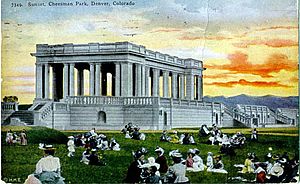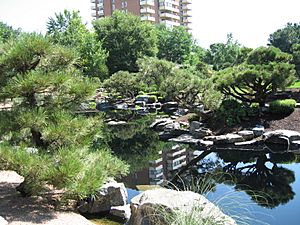Cheesman Park, Denver facts for kids
Quick facts for kids |
|
|
Cheesman Park
|
|
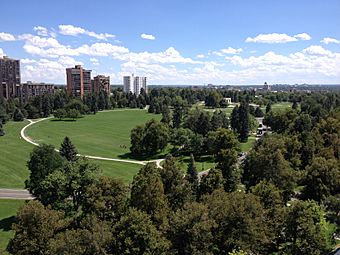
Looking across the main lawn from the northwest corner.
|
|
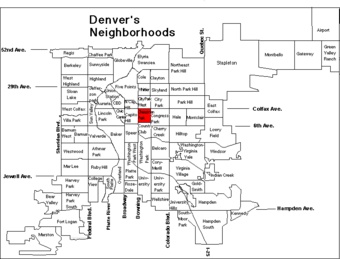
Cheesman Park highlighted on a map of Denver's neighborhoods.
|
|
| Location | Roughly bounded by E. Thirteenth Ave., High St., E. Eighth Ave., and Franklin St., Denver, Colorado |
|---|---|
| Area | 80.7 acres (32.7 ha) |
| Built | 1898 |
| Architect | Reinhard Schuetze, Marean & Norton |
| Architectural style | Classical Revival, Mission/Spanish Revival |
| MPS | Denver Park and Parkway System TR |
| NRHP reference No. | 86002221 |
| Added to NRHP | September 17, 1986 |
Cheesman Park is a beautiful urban park and neighborhood in Denver, Colorado, United States. It's a popular spot for people to relax, play, and enjoy nature right in the middle of the city.
Contents
Exploring Cheesman Park's Location
Cheesman Park is in central Denver, just southeast of the downtown area. The park itself is about 80 acres (about 32 hectares) and is surrounded by homes. It sits between Humboldt Street on the west, Race Street and the Denver Botanic Gardens on the east, 13th Avenue on the north, and 8th Avenue on the south.
What Trees Grow in Cheesman Park?
The park is home to 1,880 trees from 57 different types! You can find many kinds of trees here, including:
- American Linden trees in the western part of the park.
- American elm trees.
- Black Walnut trees.
- Green Ash trees.
- Large evergreen trees like the Colorado Blue Spruce and Douglas Fir.
The Park's Interesting Past
Before Cheesman Park became a park, it was a cemetery called Prospect Hill Cemetery. This cemetery also included the land where the Denver Botanic Gardens and Congress Park are today. City planners decided to turn the old cemetery into a park because they thought it would be a great feature for new residents moving into the area. The park officially opened in 1907.
From Cemetery to Park: A Name Change
The park was first named Congress Park because the U.S. Congress gave permission to change the cemetery into a park. Later, it was renamed Cheesman Park. This was to honor Walter Cheesman, an important person in Denver's early history. His family donated money to build the beautiful neoclassical pavilion in the park after he passed away.
Early Days of the Cemetery
The cemetery first opened in 1858, and the first burial happened the next year. In 1872, the U.S. Government found out that the land was actually federal property. They had received it in 1860 from a treaty with the Arapaho people. The government then offered the land to the City of Denver, which bought it for $200. In 1873, the cemetery's name was changed to the Denver City Cemetery.
Over time, different parts of the cemetery were set aside for various religious groups, ethnic communities, and organizations. Some sections were well cared for by families, but many others were neglected. By the late 1880s, the cemetery was rarely used and looked very run-down. It became an eyesore in what was becoming a very nice part of the growing city.
Why the Cemetery Became a Park
Real estate developers wanted a park instead of an unused cemetery. Colorado Senator Henry Moore Teller convinced the U.S. Congress to allow the old graveyard to be turned into a park. On January 25, 1890, Congress approved the change, and Teller renamed the area Congress Park.
Families were given 90 days to move the bodies of their loved ones to other cemeteries. Those who could afford it did so. However, many of the people buried there were those without families or money, so more than 5,000 bodies remained.
In 1893, the City of Denver hired an undertaker named E.P. McGovern to move the remaining bodies. He was supposed to provide a new coffin for each body and move it to Riverside Cemetery for $1.90 per body. The work began on March 14, 1893.
Unfortunately, McGovern did not do the job properly. He used smaller coffins than he should have, and the process became very messy. This caused a big scandal in the city. The Denver Republican newspaper wrote a story about it, describing the poor way the work was being done. Mayor Rogers stopped McGovern's contract. Many graves were still open, but a new contract to move the bodies was never given out.
Building Cheesman Park
The city built a temporary fence around the cemetery. In 1894, they started preparing the land for the park, even though some open graves weren't filled until 1902. Finally, shrubs were planted, and the holes where coffins had been removed were filled in. The park was finished in 1907, but many bodies were still left underground.
Reinhard Schuetze, a German-born landscape architect for Denver, created the first designs for the park. His plans included winding paths, a pavilion, a reflecting pool, and grassy areas surrounded by trees. Schuetze passed away in 1910 before the park was finished. His successor, S.R. DeBoer, completed the park, keeping most of Schuetze's original ideas. Some parts of the original design, like a central street and High Street, were later removed and replaced with grass and trees.
The Cheesman Memorial Pavilion
The Cheesman Memorial was built in 1908. It's made of Colorado Yule marble in the Neoclassical style. It sits on a raised platform with stone walls and decorative railings. Grand staircases lead up to the pavilion, like those found in Italian Renaissance gardens. At the base of the platform are three large reflecting pools. These pools were used as wading pools in the summer until the 1970s.
From 1934 to 1972, the Denver Post newspaper sponsored outdoor performances of Broadway musicals and operas at the pavilion. The famous Olmsted Brothers designed the landscaping around the memorial. In 1912, a formal walkway with flower beds was added between the memorial and Williams Street parkway.
By the 1970s, the pavilion and its supporting base were in bad shape. The city decided to restore the pavilion but replaced the old platform with gently sloping lawns and simple concrete staircases. Today, only the pavilion and reflecting pools remain from the original design. Much of the formal landscaping was lost during this time, replaced with simpler flower beds and a rose garden.
Cheesman Esplanade: Little Cheesman Park
The area at the south edge of the park, near 8th and Williams Streets, was once used as a cemetery. It later became the city's tree and shrub nursery until 1930. Then, a WPA project turned it into an addition for the park. The Catholic Church moved most of the bodies from Mount Calvary Cemetery and sold the land back to the city in 1950. This city-block-sized park is now called Cheesman Esplanade, and locals often call it "Little Cheesman Park."
Cheesman Park Today
In November 2008, during construction of a new parking garage for the Denver Botanic Gardens, some human bones and coffin pieces were found. These remains were respectfully moved to a different cemetery, and construction continued.
In 2008, the City and County of Denver suggested restoring much of Cheesman Park to its original 1902 design. This plan would involve planting more trees, removing unwanted plants, and bringing back the park's original figure-8 pathway design. The old retaining walls, fountains, and staircases around the Cheesman Memorial would also be restored, along with the gardens that once surrounded the pavilion.
Cheesman Park is a popular gathering place for community events in Denver. For example, the annual PrideFest parade often starts here in June, and the AIDS Walk Colorado takes place in and around the park every September. These events bring people together for celebration and support.
The Cheesman Park Neighborhood
The Cheesman Park neighborhood is one of Denver's oldest areas, with city maps showing it as early as 1868. It became part of the City of Denver in 1883. By 1915, after the park was finished, the neighborhood had many large mansions belonging to some of the city's wealthiest families. Since the 1930s, more apartment buildings have been built, making the neighborhood more densely populated.
Neighborhood Boundaries and History
The Cheesman Park neighborhood is bordered by Colfax and 8th Avenues from north to south, and by Downing and Josephine Streets from east to west. It's often seen as part of Denver's Capitol Hill neighborhood, especially its northern and southern residential areas. This area was once known as a "fashionable residential district" where many business and professional people lived.
The neighborhood has a lot of people living in it, with more than 12,000 people per square mile. This is much higher than Denver's average because of the many tall apartment and condominium buildings around the park. However, the neighborhood also has three historic districts: Wyman's, Morgan's Addition, and Humboldt Island. These districts protect homes built in many different architectural styles from the late 1800s to the early 1900s.
Who Lives in Cheesman Park?
The neighborhood is mostly white and middle class. In 2008, the average household income was $42,477. People in Cheesman Park generally have a higher level of education than the rest of the city. More people here are single or unmarried (only 13.2% married, compared to 34.7% for the whole city), and fewer households have children (2.6% compared to 15.0% for the city). This means the average household size is smaller.
Most people in the neighborhood rent their homes. The apartments are a mix of new and old buildings, including old mansions that have been turned into apartments. Only about a quarter of the residents own their homes. In 2008, the average price for a detached single-family home was $791,976, which was more than double the city's average.
Cheesman Park has a very urban feel because it's so dense and close to the city center. The crime rates in the neighborhood are similar to the city's average. There are several shopping and dining areas, especially north of the park between 13th and Colfax avenues. The neighborhood is also home to the 23-acre (9.3-hectare) Denver Botanic Gardens.
Cheesman Park in Movies
Cheesman Park has inspired some movies!
- Writer Russell Hunter said that his experiences living in a large house near Cheesman Park in 1968 inspired parts of the movie The Changeling. Even though the movie is set in Seattle, the house in the film is called the "Cheesman" House, as a nod to Denver.
- There are also rumors that Cheesman Park was an inspiration for Steven Spielberg's movie Poltergeist.
Images for kids



